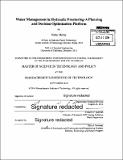Water management in hydraulic fracturing-a planning and decision optimization platform
Author(s)
Mehta, Neha,Ph. D.Massachusetts Institute of Technology.
DownloadFull printable version (14.64Mb)
Other Contributors
Massachusetts Institute of Technology. Technology and Policy Program.
Advisor
Francis 0' Sullivan.
Terms of use
Metadata
Show full item recordAbstract
Recent developments in hydraulic fracturing technology have enabled cost-effective production of unconventional resources, particularly shale gas in the U.S. The process of hydraulic fracturing is water intensive, requiring 4-7 million gallons of water per well, to which a range of chemicals must also be added in order to produce an effective fracturing fluid. Following a fracturing stimulation, anywhere from 10-40% of the injected volume of the water flows back to the surface as a polluted stream of wastewater. This polluted stream of water and the overall inefficient use of water in the hydraulic fracturing process has resulted in a number of negative environmental consequences, specifically surrounding ground and surface water quality and quantity. In considering how to minimize the environmental impacts of hydraulic fracturing, effectively managing water throughout the entire hydraulic fracturing water cycle (water acquisition and disposal) is obviously critical. This dissertation articulates a GIS based optimization model that has been developed to optimize water management planning for unconventional oil and gas production. The model enables a diverse set of stakeholders to develop customized water management strategies based on the geological characteristics and water infrastructure of any given play. The model comprises of a front end GIS interface and a back end optimization engine, designed to minimize the overall system cost of water handling as well as minimizing the overall water footprint of the system. Altogether, it is a powerful decision making tool, which allows the operators to optimize and analyze the temporal and spatial variations in flowback, and produced water management and provide an operationally convenient method to access and share the model analysis. From a regulatory perspective, the modeling framework provides a comprehensive template for a water management plan and could be used as a basis to develop tailored, customized regional solutions that can incorporate the inherent heterogeneity widespread across today's oil and gas plays.
Description
Thesis: S.M. in Technology and Policy, Massachusetts Institute of Technology, Engineering Systems Division, 2014. Cataloged from PDF version of thesis. Includes bibliographical references (pages 73-78).
Date issued
2014Department
Massachusetts Institute of Technology. Engineering Systems Division; Technology and Policy ProgramPublisher
Massachusetts Institute of Technology
Keywords
Engineering Systems Division., Technology and Policy Program.